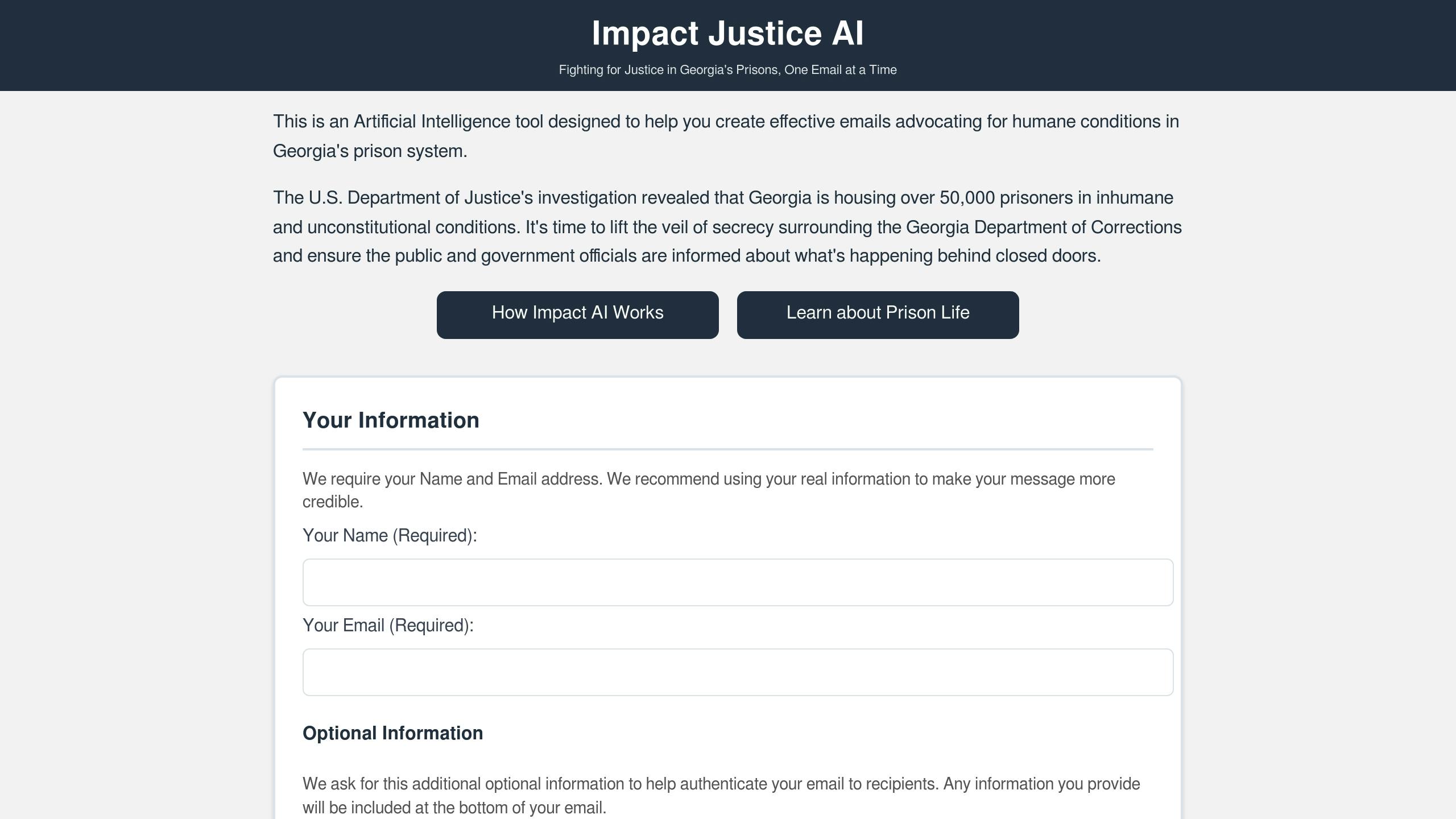Georgia’s prisons are overcrowded and understaffed, creating serious challenges in 2025. Facilities built for 750 inmates now hold 1,700 – 226% of their intended capacity. Nearly 70% of the prison population consists of pretrial detainees, worsening the strain. Staffing shortages are severe, with correctional officer vacancies averaging 49.3% and violence on the rise.
Key facts:
- Total Inmates: 36,247
- Facilities Over Capacity: 10
- Pretrial Detainees: 69.9% of population
- Average Facility Occupancy: 226%
Two tools are helping address the crisis:
- Georgia Prisoners’ Speak (GPS): A platform for inmates to report conditions, exposing issues like severe overcrowding and staffing shortages.
- Impact Justice AI: A data-driven system reducing overcrowding and violence while improving healthcare and rehabilitation programs.
Despite progress, urgent reforms are needed, including infrastructure upgrades, faster parole reviews, and better staffing solutions.
Inmate Death Highlights Staffing Crisis in Georgia Prison System
1. Georgia Prisoners’ Speak Platform

In 2024, Georgia Prisoners’ Speak (GPS) was introduced as a secure and anonymous platform for inmates to report on the state’s prison overcrowding crisis.
Through anonymous submissions, GPS has exposed the serious effects of overcrowding. For instance, at Macon State Prison, nearly two-thirds of correctional officer positions were vacant as of October 2024. This revelation sparked public outcry and calls for urgent staffing reforms [2].
The platform also uses data analytics to provide real-time insights into prison conditions. As of February 2025, the following statistics were reported:
| Metric | Current Status (Feb 2025) |
|---|---|
| Total Inmates | 36,247 |
| Facilities Over Capacity | 10 |
| Pretrial Detainees | 69.9% |
| Average Facility Occupancy | 226% |
This data helps expose systemic issues and supports efforts to bring them to public attention.
GPS works closely with legal and advocacy organizations, including the Southern Center for Human Rights and the ACLU of Georgia, to verify inmate reports and document the effects of overcrowding on critical services [2]. The platform also uses interactive visual tools to make capacity issues more accessible and understandable for the public [6].
A recent assessment of the platform highlighted its impact:
"GPS serves as a crucial tool for documenting and reporting issues within the prison system, enabling prisoners to share their experiences directly with the public and policymakers" [3].
sbb-itb-7858f51
2. Impact Justice AI System

Impact Justice AI has become a key tool in addressing Georgia’s prison capacity issues. Drawing from insights in Georgia Prisoners’ Speak, the system combines various data sources to identify and tackle these challenges head-on.
Here’s how it’s making a difference:
| Metric Category | Improvement (Feb 2025) |
|---|---|
| Staff Overtime | 15% decrease |
| Healthcare Management | 30% drop in communicable diseases |
| Violence Prevention | 25% fewer violent incidents |
| Overcrowding | 20% reduction in severe overcrowding |
| Program Participation | 40% boost in rehabilitation engagement |
The AI’s predictive capabilities have streamlined inmate transfers and facility usage, directly cutting severe overcrowding by 20% [9]. This progress is crucial in tackling the overcrowding issues previously highlighted.
By combining real-time feedback from inmates with official data, the system pinpoints pressing concerns [8]. To ensure ethical use, strict anonymization protocols and regular reviews by legal and community experts are in place [10].
Impact Justice AI also uses facility-specific data to guide decisions about staffing, healthcare, and rehabilitation programs. While challenges like inconsistent data and limited resources remain, phased implementation and better data collection continue to refine the system [11]. These findings are shaping broader reform efforts for the future.
Solution Analysis
Examining GPS.press and Impact Justice AI reveals how their combined efforts tackle Georgia’s prison overcrowding crisis. GPS.press focuses on firsthand inmate accounts, while Impact Justice AI analyzes official records and demographic data. Together, they provide a mix of real-world examples and data-driven insights that inform actionable policy proposals.
| Metric | GPS.press | Impact Justice AI |
|---|---|---|
| Data Collection | Inmate testimonials and firsthand accounts | Analysis of official records and demographic trends |
| Policy Influence | Raised public awareness and spurred debate | Delivered policy recommendations, including a potential 15% prison population cut through sentencing reforms [2] |
| System Changes | Highlighted severe overcrowding issues (e.g., Smith State Prison [1]) | Provided evidence to support administrative actions |
| Public Engagement | Garnered media attention and public support | Supplied reports to key decision-makers |
Their impact is clear in real-world examples. At Smith State Prison, GPS.press exposed overcrowding so severe that inmates had to sleep in shifts due to a lack of beds [1]. Paired with Impact Justice AI’s data on capacity issues, this led to immediate administrative responses.
Impact Justice AI also modeled the effects of sentencing reforms, showing that reducing non-violent offender sentences by two years could lower the prison population by 15% [2]. This analysis has influenced discussions in the Georgia General Assembly.
The two platforms work well together in several ways:
- Data Validation: GPS.press’s firsthand accounts back up Impact Justice AI’s findings, such as delays in healthcare caused by overcrowding [1][2].
- Policy Development: Impact Justice AI’s analysis, like identifying 10 Georgia jails over capacity in January 2025 [7], reinforces GPS.press’s advocacy for change.
- Accountability: GPS.press builds public pressure through media and grassroots campaigns, while Impact Justice AI tracks key metrics to hold officials accountable.
As of January 2025, Georgia’s prison system operated at 70.6% capacity [7]. While this shows progress, these efforts highlight the need for continued reforms to address systemic issues.
Next Steps
Georgia’s overcrowded prisons need swift and comprehensive action. Governor Brian Kemp has proposed a $600 million budget over the next 18 months to tackle critical issues like infrastructure and staffing shortages [4]. Below is a breakdown of priorities and proposed actions for both the immediate and medium term.
| Priority Area | Immediate Actions (0-6 months) | Medium-term Actions (6-18 months) |
|---|---|---|
| Infrastructure | Repair broken cell locks and address urgent maintenance | Upgrade medical facilities and expand vocational training spaces |
| Staffing | Increase salaries and start recruitment campaigns | Introduce advanced training and clear career advancement paths |
| Population Management | Speed up parole reviews and adopt electronic monitoring | Revise sentencing guidelines and develop alternative custody programs |
Addressing staffing shortages is critical. With vacancies reaching 50% systemwide – and as high as 70% in ten major facilities [1] – offering signing bonuses and overtime incentives can help attract and retain workers.
Infrastructure also needs immediate attention. The governor’s plan prioritizes fixing broken cell locks and making essential facility upgrades to improve safety and manage the overcrowding crisis [4].
Another pressing issue is Georgia’s pretrial backlog [5]. Faster indictment processes are necessary to reduce delays. The ACLU of Georgia has also called for reducing jail populations before considering new prison construction [12]. Reforming population management practices, such as parole reviews and alternative custody options, is key.
To ensure transparency and effective reforms, tools like Georgia Prisoners’ Speak (https://gps.press) and Impact Justice AI (https://impactjustice.ai) can play a crucial role. These platforms can provide real-time data and insights, helping track progress and refine strategies as needed.
